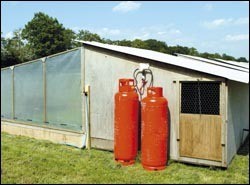Dangers of CO gas in rearing sheds evident

A warning was issued to gamerearers last week by the Health and Safety Executive (HSE) of the potential risks associated with gas-fired brooder heaters, after the death of a beater in Scotland last year from carbon monoxide (CO) poisoning.
The warning follows the conclusion of the investigation into the death of a part-time beater and gundog breeder, 37-year-old Lindsay George Redpath. Mr Redpath died at Balbirnie estates, in Fife, while he was sleeping in a pheasant rearing shed that was also occasionally used as a bothy. Carbon monoxide from a gas-fired heater accumulated in the shed and Mr Redpath died from the fumes as he slept. At the time of his son?s death, Mr Redpath?s father George highlighted that his son was, ?Well known and popular in the area and was often invited to help out on shoots with his dogs. He was very fit and hardy and loved sleeping outdoors from an early age. He went off to read a book in the bothy and that?s the last time he was seen.?
Lawrence Murray, the HSE inspector who led the investigation, commented: ?The LPG-fired heater was open-flamed and flueless ? a type that should never be used in sleeping accommodation because of the danger of death. Even though the heater was found to be in
good working order, a phenomenon known as atmospheric vitiation resulted in incomplete combustion of the fuel gas, leading to the production of high levels of CO. No-one should ever sleep in pheasant rearing sheds heated by gas-fired poultry brooder heaters.?
Though the circumstances of Mr Redpath?s death were unusual, the investigation highlighted a wider point about the importance of adequate ventilation in rearing sheds to protect those working there. Manufacturers of brooder heaters specify the ventilation requirements for their appliances and care must be taken to ensure that proper openings are utilised rather than relying on ventilation provided by gaps beneath doors and holes in walls. Ventilation arrangements should be checked by a competent heating or ventilation engineer, and should be sufficient for the maximum number of heaters used in a shed.








